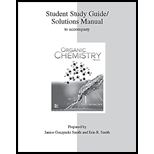
Concept explainers
(a)
Interpretation: The chemical shifts of the given absorptions are to be calculated.
Concept introduction: In NMR spectrum, peaks are known as resonances, lines or absorptions. On the horizontal axis, the position of absorption is generally referred to as chemical shift. The chemical shift of any absorption is calculated by the formula,
(b)
Interpretation: The frequency of each absorption at
Concept introduction: In NMR spectrum, peaks are known as resonances, lines or absorptions. On the horizontal axis, the position of absorption is generally referred to as chemical shift. The chemical shift of any absorption is calculated by the formula,
Want to see the full answer?
Check out a sample textbook solution
Chapter 14 Solutions
ORGANIC CHEMISTRY-STUDY GUIDE PACKAGE
- The following 1H NMR peaks were recorded on a spectrometer operating at 200 MHz. Convert each into δ units. (a) CHCl3; 1454 Hz (b) CH3Cl; 610 Hz (c) CH3OH; 693 Hz (d) CH2Cl2; 1060 Hzarrow_forwardAssign as many resonances as you can to specific carbon atoms in the 13C NMR spectrum of ethyl benzoate.arrow_forwardWhen measured on a spectrometer operating at 200 MHz, chloroform (CHCl3) shows a single sharp absorption at 7.3 δ. (a) How many parts per million downfield from TMS does chloroform absorb? (b) How many hertz downfield from TMS would chloroform absorb if the measurement were carried out on a spectrometer operating at 360 MHz? (c) What would be the position of the chloroform absorption in δ units when measured on a 360 MHz spectrometer?arrow_forward
- How many signals in 1H NMR spectrum of methyl 3-nitrobenzoate? Identify their chemical shifts and the multiplicity.arrow_forwardThe 1H NMR spectrum of methylbenzene (C6H5CH3) recorded on a 500 Mhz spectrometer consists of signals at chemical shifts of 2.21 parts per million and 7.10 ppm. calculate the frequency, downfield of TMS, of each absorption.arrow_forwardDescribe the 1H NMR spectrum of each compound. State how many NMR signals are present, the splitting pattern for each signal, and the approximate chemical shiftarrow_forward
- A signal is seen at 600 Hz from the TMS signal in an NMR spectrometer with a 300-MHz operating frequency. a. What is the chemical shift of the signal? b. What is its chemical shift in an instrument operating at 500 MHz? c. How many hertz from the TMS signal is the signal in a 500-MHz spectrometer?arrow_forwardHow many peaks woudl be observed in the 1H and 13C NMR specutrms of the following compounds?arrow_forwardUsing a 60-MHz spectrometer, a chemist observes the following absorption:doublet, J = 7 Hz, at d 4.00(a) What would the chemical shift (d) be in the 300-MHz spectrum?arrow_forward
- Organic Chemistry - How many signals would you expect in the 1H NMR spectrum of HOCH2CH2CH2CH2OH?arrow_forwardHow would integration distinguish the 1H NMR spectra of the following compounds?arrow_forwardThe 1H NMR spectrum of 1,2-dimethoxyethane (CH3OCH32CH2OCH3) recorded on a 300 MHz NMR spectrometer consists of signals at 1017 Hz and 1065 Hz downfield from TMS. (a) Calculate the chemical shift of each absorption. (b) At what frequency would each absorption occur if the spectrum were recorded on a 500 MHz NMR spectrometer?arrow_forward

 Principles of Instrumental AnalysisChemistryISBN:9781305577213Author:Douglas A. Skoog, F. James Holler, Stanley R. CrouchPublisher:Cengage Learning
Principles of Instrumental AnalysisChemistryISBN:9781305577213Author:Douglas A. Skoog, F. James Holler, Stanley R. CrouchPublisher:Cengage Learning

